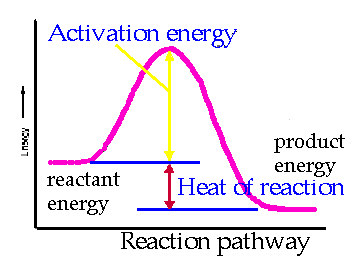Nuclear bindings are due to the interlocking of particle textures. What is known as the strong force in conventional physics is the interlocking due to this. However, the interlocking itself requires no force. Once a hook covered quantum is in direct contact with a hoop covered quantum, they stick until they are torn apart by the momentum of some other particle.
What needs to be overcome in order for nuclear bindings to occur is the enormous repelling force that exists between two positively charged particles in close proximity to each other. The repelling force exists only as long as the particles are separated from each other.
Right before two positively charged particles meet, neutrinos in between the two particles become highly charged. They bounce furiously between the two particles. Pressure builds up as the neutrinos get an increasing tendency to stay in the field.
This makes for the steep upwards journey of the "energy hill". The closer the particles get to each other, the more neutrinos get trapped in the field.
However, at a certain point, the space between the two particles becomes so narrow that neutrinos no longer find their way into the field, and we start on the descending part of the energy hill. It becomes increasingly easy to push the two particles together.
Eventually, the two particles are in direct contact, and there is no force pushing them apart. But two positively charged particles will not stick to each other. A negatively charged particle is required to form the glue. Without such a particle, the two positively charged particles will separate again, and the neutrinos will come back in between them to ensure that the separation is final.
To fuse two protons together, an electron is required.
 |
| Atomic nuclei |
From experiments, it appears that a neutrino is required too. However, this may simply be due to the fact that a fused nucleus will become a little larger than the separate parts. It will therefore have to get an extra neutrino inside of it to produce the extra pressure required for the increase in size.
When a free neutron decays into a proton and an electron and a neutrino, the neutrino may well be coming from inside the proton. It may not be part of the glue, but part of the energy structure. I suspect that atomic nuclei are made exclusively of electrons and positrons, and that the neutrinos observed come from within this hollow structure where they keep the whole from imploding.
 |
| Free neutron decay |
The story for chemical bindings is similar to that of nuclear bindings. When atoms come in close contact with each other, neutrinos get trapped in between the two electron clouds surrounding the atoms. This produces a repelling force. However, once overcome, the repulsion disappears completely. The electrons of the two atoms start bouncing off of each other's nuclei.
 |
| Chemical binding |
Again, we see that the binding itself requires very little force. It is the resistance to the binding that requires force. Once overcome, the binding forms readily.
What keeps atomic nuclei from spontaneously flying apart is the interlocking of hooks and hoops. What keeps chemical structures from flying apart is a mutual energy optimization.
When electrons bounce between atomic nuclei, the nuclei become somewhat compressed. They become smaller. They have less energy.
To tear a molecule apart, this efficient arrangement must be disrupted. The bouncing electrons must be drawn apart. The atomic nuclei will therefore grow. They absorb energy.
The "energy hill" of a chemical binding has two sides. To push atoms together, there is the mutual resistance of the electrons. To pull atoms apart, there is the mutual energy arrangement of the atomic nuclei.
Once crossed, the energy hill of a chemical binding becomes an accelerator. In the case of pushing atoms together, the reduced size of the nuclei after a successful breach of the electron on electron repulsion releases energy, accelerating the final stage of the process.
Conversely, once the efficient energy arrangement of a molecule is overcome, the mutual repulsion of electrons will accelerate the separation.
Finally, we have the gravitational binding energy of large heavenly bodies.
When two such bodies come in close proximity to each other, there is mutual repulsion due to the electric charge at their surfaces.
 |
| Electric repulsion, gravitational attraction |
Large bodies will not generally merge due to this charge. At close range, large bodies repel each other. However, should the mutual repulsion be breached, the two bodies will merge, and capacitance will set in to hold everything together.
While the outer surface of large bodies are negatively charged, the inner surface of such bodies are positively charged. This means that the inner and the outer surface attract each other.
 |
| Cross section of hollow planet |
Once merged into a single body, the resulting body will resist being split up, and capacitance is the mechanism that ensures this. However, large bodies do at times split up due to external stress. When this happens, there will be a similar effect to the one described for chemical molecules.
Once the energy hill posed by capacitance has been breached, electrical repulsion sets in and the two bodies are permanently separated.
 |
| Moon ejected from Jupiter |

No comments:
Post a Comment